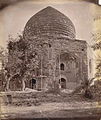- Abdul Hasan Asaf Khan
-

Abdul Hasan Asaf Khan was the father of Arjumand Banu Begum, also known as Mumtaz Mahal, who was the wife of the Mughal Emperor Shah Jahan, the Emperor of India. Asaf Khan was also the elder brother of Mehrunissa, (better known as Nur Jahan), the empress of Shah Jahan's father, Jahangir. Many scholars have been researching on the origins of Asaf Khan's clan. Some researches claim they are descending from Armenia, but most likely from Persia. His other daughter Parwar Khanam was married to Mohtashim Khan, the son of jahangir's foster brother Qutubuddin Koka. Her masoleun is located in Sheikhpur, Badaun
Asaf Khan was appointed Governor of Lahore by Emperor Jahangir in 1625. After the demise of Jahangir in 1627, he was instrumental in securing the accession of his son-in-law Shah Jahan by colluding with Dawar Bakht (Jahangir's other son) and defeating the rival claimant Prince Shahryar (Nur Jahan's son-in-law, married to her daughter by her previous marriage to Sher Afghan) in a battle near Lahore. Asaf Khan enjoyed a position even more elevated than in the preceding reign and retained it until 1632, when he failed in the siege of Bijapur, from which time he seems to have lost favour.
Asaf Khan died on 12 June 1641 while engaged in fighting against the forces of rebel Raja Jagat Singh Pathania. His tomb was commissioned to be built in Shahdara tomb complex in Lahore by Shah Jahan. It is built to the west of Jahangir's mausoleum, facing it. The tomb is built entirely of brick. It is of octagonal plan, with a large central double-layered bulbous dome. Each side has a deeply recessed iwan, or alcove, with a door and arched window looking into the tomb. Marble, and blue kashi tiles typical of Lahore once covered the mausoleum; they have since been stripped off. The interior was renowned for its lavish use of white marble and precious stone inlay, which had been removed. The inner dome ceiling is decorated in a high plaster relief of interlacing patterns, but much of it has fallen off. The tomb contains the marble sarcophagus, carved with Koranic inscriptions, similar to that in Emperor Jahangir's adjacent tomb.
The historian Hargreaves says about the tomb, "Despite its simplicity, there is a sense of restful quietude at this site (Asaf Khan's Tomb) which renders it one of the most fascinating monuments in the neighbourhood of Lahore."
Gallery
See also
External links
This biography of a member of a noble house or article about nobility is a stub. You can help Wikipedia by expanding it.





